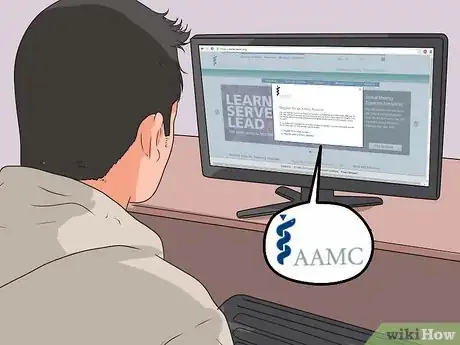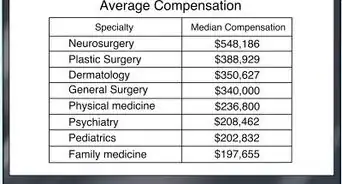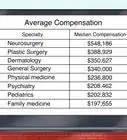This article was co-authored by Felipe Corredor. Felipe is a Senior College Admissions Consultant at American College Counselors with over seven years of experience. He specializes in helping clients from all around the world gain admission into America's top universities through private, one-on-one consulting. He helps guide clients through the entire college admissions process and perfect every aspect of their college applications. Felipe earned a Bachelor's Degree from the University of Chicago and recently received his MBA.
There are 9 references cited in this article, which can be found at the bottom of the page.
wikiHow marks an article as reader-approved once it receives enough positive feedback. This article received 15 testimonials and 100% of readers who voted found it helpful, earning it our reader-approved status.
This article has been viewed 827,071 times.
Have you ever dreamed of becoming a doctor? The medical school process can be a little overwhelming, but thousands of students do it every year, and you can do it too. Let this article help you take your first steps on the path to becoming a physician.
Steps
Earning an Undergraduate Degree
-
1Fulfill specific course requirements. As long as you complete the requirements (mostly scientific in nature), you can major in anything you would like. For example, you must take courses in biology, chemistry, and physics to prepare for the Medical College Admissions Test (MCAT) and fulfill medical school prerequisites. As a result, many pre-med students major in a field of science. Medical schools are looking to diversify their programs, so they are starting to accept more students with less conventional backgrounds that include degrees in fields such as humanities. As of 2015, you will need the background of one semester of introductory psychology and one semester of introductory sociology to be prepared for the Psychological, Social, and Biological Foundations of Behavior section of the MCAT.[1]
-
2Make grades your number one concern. It is important to have a high GPA in order to be a strong medical school candidate. Whatever major you choose, make your performance in the classroom your main focus.[2]
- Be an exemplary student. Attend all of your classes each time they meet, schedule lots of time for reading and studying and do not hesitate to get help from another classmate or a tutor the minute you realize you are struggling with any of your subjects.
- Focus on BCPM. BCPM stands for "Biology, Chemistry, Physics, and Mathematics"; these are the core classes for a pre-med major because these courses are prerequisites for any medical school program.
- Your BCPM grades are so important that when you apply to medical school, your scores in these classes will be separated out and an additional GPA will be calculated for these classes alone and reviewed along with your cumulative GPA in all of your classes.
Advertisement -
3Identify professors with whom you feel a connection or whose classes you particularly enjoy. Do your best to get to know them and learn if they are accessible to offer guidance or answer questions. In a couple of years, you will need letters of evaluation from individuals who know you and your work, and one of your professors might agree to write such a letter if he or she feels they've made a connection with you.
- Attend department and informal functions where it might be easier to talk casually and openly with instructors.
- Look for opportunities to meet alumni who have gone on to medical school or those who are working now as physicians. You can learn a lot about what to expect in medical school by talking to someone who has been there themselves.
-
4Have a well-rounded college experience. Plan to get involved in activities both related and unrelated to your major and look for opportunities on and off campus to develop personal, leadership, research, and clinical skills.
- Be sure to join any health-career clubs on your campus and get on the mailing list so that you will receive notices about events and activities. The Association of American Medical Colleges (AAMC) Premed Navigator is a helpful monthly newsletter which features important topics, resources, tips, and key dates for aspiring physicians.
- Approach the campus health clinic to look for volunteer positions there, and, if your school has a research facility, check for opportunities to assist in some way.
- Go off campus to explore ways to get involved in the local community health center, at health fairs or teaching children about basic health topics. See if a local public school might be looking for candidates to take to kids about health care careers.
-
5Get clinical experience. There is a world of difference from learning the fundamentals in a classroom and practicing those skills with actual patients. You must find ways to get hands-on experience in a health care setting. Reach out to your local Planned Parenthood office, HIV clinic, or free clinic to volunteer.
- The author of an article that appeared in U.S. News and World Report said several admissions committee members he spoke to referred to clinical experience as "the unspoken requirement."
-
6Show that you are committed. The occasional one-time volunteer job is fine, but you want to choose a couple of organizations or causes about which you are passionate and make a regular (once-a-week or once-every-other-week) commitment over a sustained period of time.
- Seek out under-served populations. Medical schools are not only looking for students with great grades, they want people who are caring and want to make a difference. Working to provide health care and health education to under-served or at-risk populations can help communicate your compassion.
-
7Be a leader. Being a physician means being in charge of a lot--diagnosis, treatment, medications, follow-ups and on and on. Hone your skills as a leader by heading up a group or a committee and be sure to set, achieve and record your goals for your organization.[3]
-
8Get an internship. Internships for pre-med students typically fall into one of two categories: research or clinical. Decide what most interests you and focus your efforts there.
- Start with your adviser. Your adviser or health-career services office should have a list of internships available. Many times, schools establish relationships with doctors, hospitals, and health care organizations who, in turn, regularly accept student interns from that school.
- Apply early. The time to be thinking about summer internships is in the fall of the preceding year. At minimum, start three to four months out, but do not be surprised if there are fewer opportunities available.
- Be proactive. Talk to older students or alumni to find out about internship sites they would recommend or get and review a list of places that offered internships last summer. Contact those organizations on your own before they post or advertise their upcoming internships for the general pre-med population.
-
9Prepare for future tasks. While you're busy working on your grades, extracurricular activities and internships, you also need to keep in mind about upcoming requirements and deadlines that are a part of the med school applications process.
- Get familiar with the AAMC Fee Assistance Program. The AAMC Fee Assistance Program assists those who, without financial assistance, would be unable to take the Medical College Admission Test® (MCAT®), apply to medical schools that use the American Medical College Application Service® (AMCAS®), and more. Learn more about benefits and eligibility here.
- Take the MCAT junior year. There are two factors to consider when deciding on the timing of your Medical College Admission Test (MCAT): whether you plan to take the exam more than once and how prepared you feel.
- If you think you might want to take the test more than once, plan to make your first attempt before May 1. This will give you plenty of time to get your scores and make a decision about retesting.
- Most people do not plan on taking the exam multiple times, and some argue that it will hurt your chances. Like all things in life: if it's worth doing, it's worth doing right the first time.
- If you don't feel prepared academically or there are elements in your personal life that are making it difficult for you to focus, put your efforts into your coursework and on getting in a good place mentally for the test. It would be perfectly fine if you waited until June or July to take the exam. Even people who take the exam in August can apply for that cycle.
- If you think you might want to take the test more than once, plan to make your first attempt before May 1. This will give you plenty of time to get your scores and make a decision about retesting.
Get Familiar With AAMC, AACOM, AMCAS, and AACOMAS
-
1Create an AAMC and/or AACOM account. The Association of American Medical Colleges is responsible for administering the MCAT exam, so you must create an account with a username and password you will use to register for the test. Your AAMC account also gives you access to practice exams and fee assistance programs.[4]
-
2Read the AMCAS and/or AACOMAS instruction manuals. The American Medical College Application Service and American Association of Colleges of Osteopathic Medicine Application Service are centralized application processing services available to students applying to their first year of medical school. The good news is, no matter how many medical schools you apply to, you only have to submit one online application. The less good news is that the process can be a bit overwhelming, so it's best to begin by reading the thorough instruction manual (85 pages at last count)so you know what to expect.
-
3Start the application process. Applying to medical school is a multistage process, so start early so that you can collect and record accurate information and devote time to your admissions essay.
- Identifying information. This section captures basic information such as name, gender and social security and/or other identifying numbers.
- Schools Attended. In this section, you will record information about the high school and colleges you have attended including study abroad programs and military education.
- Biographic information. Here is the place where you will record information that includes citizenship status, family make-up and relationships, military service and criminal background.
- Course Work. Students have identified this as the most difficult section to complete. The best way to go about it is to request transcripts from every school you attended after high school and use those transcripts to enter detailed information about all the classes you have taken.
- Work and Activities. You have the opportunity to enter information about your work experience, extracurricular activities, awards, honors, or publications in this section. You are limited to 15 entries, so choose wisely and know that some of the things you list you will designate as your “most meaningful” experiences.
- Letters of Evaluation. Here you will enter information about each letter of evaluation being sent to AMCAS or AACOMAS. You can make up to 10 letter entries and update them throughout the application process right up until you submit your applications.
- Medical Schools. This is the place where you will select the schools to which you plan to apply. You can also use this section to designate the schools you wish to receive specific letters of evaluation.
- Essays. This is where you will write your personal statement to convey your genuine interest in becoming a physician and how you believe you will be an asset to the school and to the profession.
- Standardized Tests. Enter or edit future MCAT tests dates here along with your test scores and any additional test information such as scores from the GRE is applicable.
Take the MCAT
-
1Register for the MCAT. The Medical College Admission Test (MCAT) is designed to determine how well you have mastered basic concepts in biology, general chemistry, organic chemistry, physics, psychology, sociology, and biochemistry along with your ability to solve problems and think critically.[5]
- The test is offered multiple times throughout the year from January to September. Registration opens in October for all the winter and spring test sessions, registration for summer and fall opens in February.
- The test is broken into four sections: Biological and Biochemical Foundations of Living Systems; Chemical and Physical Foundations of Biological Systems; Psychological, Social, and Biological Foundations of Behavior; and Critical Analysis and Reasoning Skills.
- Register online using via your AAMC account. The registration fee for the MCAT exam is $305; this covers the cost of the exam and distribution of your scores. Additional fees are may be given for late registration, changes to your registration, and testing at international test sites.[6]
- View the calendar on the AAMC website for a list of registration, late registration and exam dates.
-
2Study for the MCAT. The MCAT is a challenging exam with a total content test time of four hours and five minutes. You'll perform better and feel more confident if you start studying early and prepare thoroughly.
- Take a class. Choose a professionally designed MCAT course such as Princeton Review or Kaplan to give you an overview of the exam, tools, and practice you will need to earn the best possible score.
- Be sure the class is led by a highly qualified instructor and is kept small so you can receive one-on-one help.
- Join a class that meets a few months before your exam date. By doing so, you can take what you learned in the class and spend time on your own reviewing and reinforcing the material.
- Hire a tutor. Some students who have received high scores themselves on the MCAT exam offer themselves as tutors for those who plan to take the test. They can help assess your abilities and determine and help correct any areas of weakness. Know that this isn't a necessity for all cases. Even if you don't plan on hiring a tutor, make sure to start studying early to improve your chances.
- Take practice exams. It is one thing to know the kinds of questions that will be on the test, but it is another to try answering those questions following the real test format and timing guidelines. Working with practice exams is great preparation--both academically and mentally-- for test day. Practice questions and tests are widely held as the most crucial part of exam training. As your test day approaches, shift your efforts to completing more questions.
- The AAMC website offers practice exams or you can buy test prep books with sample tests or find practice exams online.
- Take a proctored exam with other students. This will give you an accurate sense of what the testing environment will be like so you will know how much focus you will need to perform well in a room filled with other students.
- Some MCAT classes include practice testing, so if you plan to take a class, look for one that offers that feature.
- Take a class. Choose a professionally designed MCAT course such as Princeton Review or Kaplan to give you an overview of the exam, tools, and practice you will need to earn the best possible score.
-
3Take the exam. Anxiety is common when facing this important exam, but knowing what to expect and being ready will help put some of your fears to rest.
- Check in at least 30 minutes prior to your appointment time for the exam admission. Your ID will be verified and you will be given a key and a locker for your personal items, a copy of the admissions procedures and a seat assignment.
- Be prepared for security. A digital image of your fingerprint will be taken and you will be scanned with a metal detector wand when you enter (and every time you re-enter) the room. The only things you may bring with you into the room are your ID and a pair of earplugs (sealed and inspected by the test center administrator). You may be asked to turn your pockets inside out to show that they are empty. Your photo ID must be visible on your desk at all times.
- Dress comfortably. It is difficult to predict how warm or cool a room will be, so it might make sense to dress in layers. However, if you need to remove an article of clothing, you will have to put it in your locker and the clock will not stop for you to do so. Hats and headscarves are not allowed (unless for religious purposes), and if you are wearing a hoodie, the hood must stay down at all times; it cannot be pulled up onto your head.
Apply to Medical School
-
1Search for medical schools. Medical school is a huge commitment of time, money, and effort. Be sure to pick the one that best suits your career goals.
- Consider your chance of acceptance. You can use online tools that allow you to enter your MCAT score and GPA into a database that will then compare your scores with the average from each medical school in the country and give you a sense of how competitive you are. This may be an example of building a list of schools you might want to consider.
- Find the balance between being realistic and aiming high. Top 10 medical schools receive thousands of applicants and send out almost as many rejections. Pick a range of schools to apply to--one or two "reach" schools (ones you may not get into) as well as schools whose average MCAT scores and GPAs are in line with your own plus a "safety" school (one you feel certain you'd be accepted to). Many American students apply to medical schools in Caribbean countries as part of their "safety" school strategy.
- Talk to alumni. If you really want to know about a school from a student's point of view, talk to a student who has been there. Seek out people who attended the schools you are interested in and ask them about the coursework and faculty as well as about social life.
- Consider cost. Medical school is expensive, so you have to look at cost when you are deciding where to apply. If you are interested in a school that you cannot quite afford, find out about scholarship opportunities. If cost is a major consideration, focus your search on state schools, as they are generally less expensive than private schools.
- Most students have to take out loans to finance their med school education. It takes a number of years to establish yourself as a physician and to be able to pay back your loans. Try not to overburden yourself financially if possible. You do not want your debt to cause extreme stress or to find that it will later limit your career options.
- Think about location. Medical school is grueling and it will not leave you much time for family and friends, but you should still ask yourself how far away you want to be from your support system. Think, too, about what kind of setting you like (small town or big city), whom else you might know at school, and how easy it is for you to make friends.
-
2Apply through your AMCAS or AACOMAS account. Chances are, you will be able to create just one application via AMCAS or AACOMAS that will be accepted by all of the schools you are interested in. Keep in mind that not every school in the United States uses AMCAS, osteopathic medical schools use a similar service known as AACOMAS, so if you're applying to a school with a different application process, find out what's required. Information about all sections of the application mentioned above. In particular, keep these "must-dos" in mind:
- Make sure there is an MCAT score on your application
- Provide complete information about your coursework via transcripts from all post-secondary educational institutions.
- Notify AMCAS of all the letters of evaluation you are expecting to have and what schools they should be sent to.
-
3Pay the fees. There are a number of costs associated with getting into medical school. Keep these in mind upfront so that you can set aside the money you'll need to complete this process.
- The most significant fees are those related to your medical school application itself. For the 2019 AMCAS application, the processing fee is $170 (includes one school) and $40 for each additional school. Most medical schools require a secondary application, the cost of which usually ranges from $0 to $150, but can be greater. Some schools will waive the secondary application cost if you qualify for the fee assistance program. There may be a small fee from your college registrar for your transcripts and occasionally schools charge a a fee for the transmittal of letters of recommendation.[7]
- Include travel costs. If you visit different medical schools as part of your decision-making process, you will have to put out money for gas, airfare, lodging, and food.
-
4Complete your application. It will take several hours to complete your application. You can choose to do it all in one sitting or break it up into small chunks, perhaps completing a couple of sections at a time.
- The basic information of the application is straightforward. Have all the information you may need to complete the first three sections that focus on basic, identifying information.
- Invest time in your essay. Your essay is essentially your opportunity to speak directly to the admissions officers who will be reviewing your application. What is most important is that you discuss what attracted you to the field of medicine and how you plan to use your degree to help others.
- Avoid taking a philosophical or overly creative approach to your essay and avoid talking about information that has already been covered somewhere else in your application or overfill it with details in the hopes of impressing. This is meant to be your personal statement, so focus on the "personal" aspect and give readers some insight into who you are and your career goals.
-
5Get your letters of evaluation. Ask professors with whom you've developed a relationship or community or group leaders or employers with whom you've worked to write a letter that speaks to how well suited you are for a career in medicine and positively predicts your success as a doctor.
-
6Mind the timeline. The deadline for medical school application submissions differs from school to school with some asking for information a year ahead of the expected admissions date. That means you should be working on your application at least 18 months in advance of your desired enrollment date. If you are interested in Early Decision, the dates could be even sooner, so get to work on your application materials junior year.
-
7Wait for a response. Turnaround time for acceptance notification can range from a few days to several weeks. While it's definitely nerve-wracking to be waiting for news, try to stay focus on your studies and avoid making any alternate plans until you've gotten all of your responses.
- Do not allow your grades to drop during this time. Medical schools look for upward trends in GPAs so crashing and burning your senior year will only hurt your future chances.
- If you don't get accepted to the school you wanted, there are things you can do to make yourself a desirable candidate in the future or other career paths you could follow.
- Retake the MCATs. You can take them three times in a calendar year), working for a year or two before reapplying or attending graduate school.
- Take time off. The average age a student entering medical school is now 24, with a considerable number of students applying later. Not only do medical schools appreciate mature applicants who learned from their mistakes, but if you take time off you will have more time to prepare a more competitive application.[8]
- Consider osteopathic schools. Look into pursing a D.O. instead of an M.D. This field is less crowded but still has high standards. According to the American Association of Colleges of Osteopathic Medicine, in 2010 the average entering osteopathic student had a 3.47 GPA.[9]
Community Q&A
-
QuestionCan an average student get into medical school?
 Cole LindwallCommunity AnswerNo, medical schools are very selective and only accept the best students. However, if you dedicate time and effort towards school and preparing for exams, you will be in this elite class of students.
Cole LindwallCommunity AnswerNo, medical schools are very selective and only accept the best students. However, if you dedicate time and effort towards school and preparing for exams, you will be in this elite class of students. -
QuestionCan I get into medical school if I have only taken math, chemistry, and physics?
 Community AnswerYes, there are a handful of universities that do not ask for Biology as a subject for undergraduate applicants to medicine (in the UK). You could perhaps do a degree in Biology or chemistry and then apply for postgraduate medicine in the US or any other country as well. Math as a higher level subject in your secondary school is helpful as some universities appreciate higher level maths as a subject. To enhance your experience with biology, you could take a course outside of school or do some volunteering/work experience to spruce up your essays.
Community AnswerYes, there are a handful of universities that do not ask for Biology as a subject for undergraduate applicants to medicine (in the UK). You could perhaps do a degree in Biology or chemistry and then apply for postgraduate medicine in the US or any other country as well. Math as a higher level subject in your secondary school is helpful as some universities appreciate higher level maths as a subject. To enhance your experience with biology, you could take a course outside of school or do some volunteering/work experience to spruce up your essays. -
QuestionCan you major in anything and still be a strong candidate for Medical School?
 Community AnswerYes. In fact, many English majors get into Medical School frequently. However, you do have to take all the courses required for the MCAT and for Medical School.
Community AnswerYes. In fact, many English majors get into Medical School frequently. However, you do have to take all the courses required for the MCAT and for Medical School.
Warnings
- If you find that all the science classes take up too much time or are just too difficult, consider switching into something more in tune with your natural abilities. Medical school is far worse than undergraduate science classes; the average load is 25-30 credit hours/semester, nearly all science courses.⧼thumbs_response⧽
References
- ↑ http://collegeadmissions.testmasters.com/pre-law-pre-med-what-do-i-major-in-part-1/
- ↑ https://www.ivywise.com/blog/medical-school-admissions-101-how-important-is-gpa/
- ↑ https://hbr.org/2018/10/why-doctors-need-leadership-training
- ↑ https://www.acceptmed.com/blog/the-difference-between-amcas-vs-aacomas-medical-school-applications
- ↑ https://students-residents.aamc.org/taking-mcat-exam/taking-mcat-exam
- ↑ https://students-residents.aamc.org/applying-medical-school/article/2015-mcat-registration-fees/
- ↑ https://students-residents.aamc.org/financial-aid/article/the-cost-of-applying-to-medical-school/
- ↑ http://www.usnews.com/education/blogs/medical-school-admissions-doctor/2012/01/09/what-to-consider-when-applying-to-medical-school-with-a-low-gpa
- ↑ http://www.usnews.com/education/blogs/medical-school-admissions-doctor/2012/01/09/what-to-consider-when-applying-to-medical-school-with-a-low-gpa
About This Article
If you think you want to get into medical school, try to get the best grades you can in Biology, Chemistry, Physics, and Mathematics since those are the prerequisites for any medical school. While you’re in college, get as much clinical experience as you can by volunteering at Planned Parenthood or a similar clinic, since this will give you valuable experience. Finally, study for the MCAT test and apply to medical school once you pass. For tips on how to study for the MCAT test more effectively, scroll down!





















































































Medical Disclaimer
The content of this article is not intended to be a substitute for professional medical advice, examination, diagnosis, or treatment. You should always contact your doctor or other qualified healthcare professional before starting, changing, or stopping any kind of health treatment.
Read More...